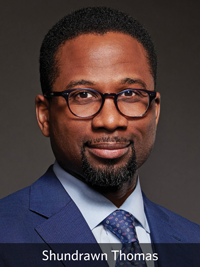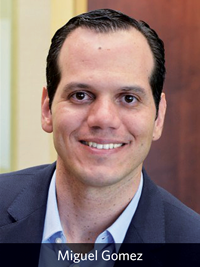The long-running discussion about the need for the wealth management industry—and the financial services industry at large—to diversify its ranks has taken on a greater sense of urgency during the past month in the wake of the protests for racial justice and equality following the deaths of George Floyd and other African Americans resulting from police actions.
Regarding financial planning, it has been well-documented that the profession predominately comprises older white males (the average age among financial advisors is somewhere in the early 50s, depending on the source).
 Shundrawn A. Thomas, President of Northern Trust Asset Management
Shundrawn A. Thomas, President of Northern Trust Asset Management
For more than 25 years I’ve worked in financial services providing investment advice and solutions to institutional investors, financial advisors and affluent families. While some may suggest it should not matter, I am African American. This perspective, combined with my professional experience and leadership role, informs my viewpoint on what we as an industry must do to translate our ideals of diversity, equity and inclusion into meaningful progress.
Let’s begin by framing the opportunity. Women account for only about a quarter of the more than 80,000 certified financial planners, while African Americans and Latinos account for less than 4%. These percentages are materially lower among all registered advisors. For a variety of reasons, our industry has failed to capitalize on the vast potential of a more diverse and inclusive workforce. While there are systemic issues that must be ameliorated, I offer several practical tactics that firms can immediately pursue in order to advance diversity, equity and inclusion.
To achieve diverse representation, firms must commit to hiring diverse professionals directly into advisor roles and leadership positions. I am keenly aware of the skills required to excel as a financial advisor, and I can unequivocally attest that there are many talented diverse individuals who can excel in these roles if provided the opportunity. Team-based structures are often most effective for ensuring the success of diverse professionals. Given industry consolidation, and that the average age of advisors is in the 50s, it is particularly timely for forward-looking firms to increase diversity. Emphasizing client-facing roles and starting at the top paradoxically provides the foundation for sustainable progress.
Equity is principally about equal access to opportunities and career advancement. To realize equity, firms must change existing talent management practices. Diverse professionals are historically less likely to be attracted to our industry and diverse communities are underserved by financial advisors. This is a lost economic opportunity for the industry—and society as a whole. Specifically, firms should develop a robust talent pipeline by partnering with organizations such as the Toigo Foundation, the Association for Latino Professionals in Finance and Accounting, and Girls Who Invest. Firms must expand recruiting by targeting Historically Black Colleges and Universities, as an example. Finally, sponsorship and mentorship must be provided for diverse professionals at each step along the employee journey.
When it comes to inclusion, here’s the best advice I can offer: intentionally diversify the client base. The lack of diversity among advisors is generally reflected in the client mix of advisor firms. Interestingly enough, U.S. wealth among women now represents a greater share than for men, with large share increases globally. Wealth among ethnic minorities is growing at a faster rate than among whites. The only way firms will become truly effective at achieving a more diverse client base will be to develop a more inclusive culture. This will in turn make inclusion a business imperative. I’m fortunate to work with a wonderfully diverse team and, together, we are putting these principles into practice to build a better future.
 Reshell Smith, Founder and CEO of AMES Financial Solutions in Ocoee, Fla.
Reshell Smith, Founder and CEO of AMES Financial Solutions in Ocoee, Fla.
The financial services industry has always struggled with attracting African American employees. For countless reasons, the industry has failed to get it right. It is time to change. Our country is in the midst of a major shift—much of it is economic. For that reason alone, the financial services industry should be leading the way. But just like other industries, many companies in our industry are searching for answers on how to be more inclusive and less biased, as well as how to attract top talent. Here are five ways you can show the African American community that your company wants to change its culture and attract their talent:
• Get involved in the community. Show African Americans that you care about the people, places, things and experiences that are important to them. They are passionate about celebrating their culture. There is Black History Month, Juneteenth, homecoming season at Historically Black Colleges and Universities, Martin Luther King Jr. Day and more. Think of McDonald’s 365, Google’s “A Celebration of Black History Makers” and Nike’s Black History Month collection. Establish partnerships with leaders in the community who spearhead events for these types of occasions, and then participate.
• Show them that representation matters. The financial services industry does not look like an industry where minorities can be successful. Whether you’re a large wirehouse firm or a small RIA practice, expand your marketing efforts to include more African Americans in your advertising. And whether your company uses traditional marketing, social media or a combination of both, the face of your company needs to be diverse; otherwise, it will continue to be ignored. There is a saying in the black community: “You should work and shop where you are appreciated, not where you are tolerated.”
• Partner with Historically Black Colleges & Universities. This should not be a basic partnership; it needs to be elaborate. A basic partnership calls for you to have a booth at an open house or send out a representative on Financial Literacy Day. Being elaborate means you do those things plus offer scholarships for tuition throughout the year and/or offer summer internships. For those taking industry exams, you cover the fees. And most important, you offer graduating students the opportunity to work with your company.
• Be clear about your company’s career options. Having been in the financial services industry for over 20 years, first at a large national firm and now with my own financial planning practice, I understand there are many career options. For someone on the outside considering a career in this industry, those options are not so clear. I imagine they may be thinking what I once thought—that you had to dress up in a suit and knock on doors or go work on Wall Street to be successful. They do not know about the compliance department, or the diversity and inclusion manager or director of operations. Clarity on the different career paths will almost certainly attract more candidates.
• Invest in training and development. Your employees are your most important asset and training them should be your top priority. If you want to attract and retain black employees, they need to see there is a path forward within the company. Keeping their knowledge fresh, skills innovative and confidence elevated are all keys to maintaining their loyalty. People are more prone to want to work for a company where they see employees who have longevity.
It is time for the financial services industry to get this right. Let’s make this shift along with the rest of the country. This shift has to be significant and impactful. Along with everything discussed, make sure you disrupt the boardrooms and upper management.
 Miguel Gomez serves as Wealth Advisor (Hispanic Investors) at Lauterbach Financial Advisors in El Paso, Texas
Miguel Gomez serves as Wealth Advisor (Hispanic Investors) at Lauterbach Financial Advisors in El Paso, Texas
We all know how the average financial advisor looks. This has been described in many studies. And we all know that the wealth gap is a real issue. The question now is, where do we go from here?
One example is the “fee for service” model, such as the one promoted by XY Planning Network. It is not a coincidence that XYPN has a more diverse pool of advisors relative to the industry as a whole and, as a result, communities that have been typically underserved (or flat-out ignored by the industry) are now getting fiduciary, unbiased financial advice.
Another model that could get more traction is the one used by firms such as Financial Finesse that deliver financial wellness as an employee benefit paid by the employer. In this case the advisor’s job is not to sell, as her salary is paid by the employer that hired the financial wellness firm. Who is served through this service? All the employees of a company, from janitorial to the C-Suite. There’s no distinction based on wealth or income.
These two approaches could help serve more diverse populations and would certainly make a tremendous difference for many consumers.
If changing your business model does not sound practical to you, then at least consider offering an hour per month of pro-bono financial planning services. Imagine the lives that you can change. I see it every week from the comments I receive from people who listen to my podcast.
And then there’s the larger question: How do we diversify the financial industry itself by diversifying the talent pool?
It begins with the desire to do so. Look for talent where you typically don’t. And, once you find it, recognize that you will probably need to do things you weren’t expecting to do. It happened at my firm when I first joined them more than 10 years ago.
I came from a very different background than all the other advisors and executives at the firm. My English was rough. I had a desire to do many things, and the firm was open to those discussions and to executing on those that made sense. They offered me help in the areas where I needed it. They didn’t try to fit me into a mold. Instead, they mentored me and gave me the opportunity to shine with my own talents and abilities.
And, of course, they have challenged me to be better and to grow. I wish for all of my fellow Latino, Black and other advisors from underrepresented groups to experience what I have experienced. I don’t think it’s been easy for my colleagues, but I think we’ve all grown as a firm as a result.